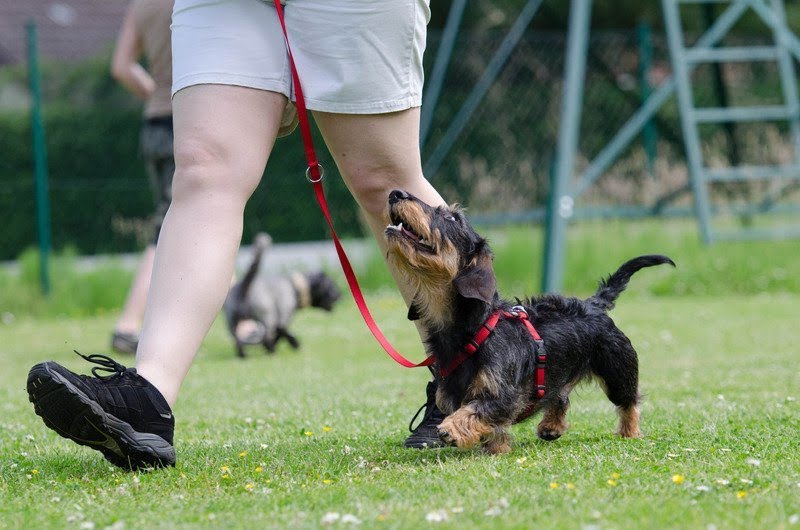Can you train a dog not to hump other dogs? Humping behavior in dogs can be embarrassing and uncomfortable for both the pet owner and the other dogs involved.
Understanding the reasons behind this behavior is crucial in order to effectively address it through training and prevention techniques. This article will explore the various aspects of humping behavior in dogs, including the reasons why they do it, the importance of training them not to do so, and techniques for achieving this goal.
Identifying the reasons why dogs hump other dogs is an essential step in addressing this behavior. Whether it’s due to sexual arousal, dominance, playfulness, or even anxiety, understanding the underlying cause can help determine the most appropriate training approach. The importance of training a dog not to hump other dogs goes beyond just preventing discomfort for owners and other pets. It can also impact their overall behavior and social interactions.
In this section, we will delve into the various techniques for training a dog not to hump other dogs. From establishing clear boundaries and teaching alternative behaviors to using positive reinforcement, there are several effective strategies that pet owners can implement.
Additionally, we will provide valuable tips for preventing humping behavior in dogs and highlight common mistakes to avoid when trying to address this issue on your own. If all else fails, seeking professional help may be necessary for dogs exhibiting excessive humping behavior.
Identifying the Reasons Why Dogs Hump Other Dogs
Understanding the behavior of humping in dogs is essential in identifying the reasons why dogs hump other dogs. Humping, also known as mounting, is a natural behavior in dogs that can occur for various reasons. It’s important to note that humping is not always sexual in nature and can be a form of play, dominance, or even a response to excitement or anxiety.
One of the main reasons why dogs hump other dogs is to assert their dominance. This behavior is more common in unneutered male dogs, but it can also be exhibited by females. Dogs may also hump as a way of seeking attention, relieving stress, or expressing excitement. In some cases, medical issues such as skin conditions or hormonal imbalances can also trigger humping behavior.
Training a dog not to hump other dogs is crucial for several reasons. Not only can excessive humping be embarrassing and inconvenient for dog owners, but it can also lead to conflicts with other dogs and their owners. Additionally, it can be uncomfortable for the dog being mounted and may result in aggressive behavior from the other dog.
| Reasons for Humping | Consequences of Humping |
|---|---|
| Dominance assertion | Conflicts with other dogs |
| Attention-seeking | Discomfort for mounted dog |
| Relieving stress or anxiety | Aggressive behavior from other dog |
The Importance of Training a Dog Not to Hump Other Dogs
Humping behavior in dogs can be embarrassing and even cause discomfort for both the dog and their owner. It’s important to understand that humping is a natural behavior for dogs, but it can become a problem if it occurs excessively or in inappropriate situations. Training a dog not to hump other dogs is crucial for their social interaction with other pets and to prevent any potential conflict or discomfort.
There are several reasons why training a dog not to hump other dogs is important. Firstly, it ensures the safety and well-being of all dogs involved in social interactions. Excessive humping can lead to fights between dogs, causing injuries and stress. Additionally, allowing a dog to hump other dogs indiscriminately can lead to discomfort and frustration for the receiving dog, as well as potential misunderstandings between owners during playdates or trips to the dog park.
To address this issue effectively, there are several techniques and tips that dog owners can use when training their pets not to hump other dogs:
- Positive reinforcement: Using treats, praise, and rewards when the dog displays appropriate social behavior without humping
- Managing the environment: Keeping the dog on a leash during initial interactions with other dogs and gradually increasing freedom as they demonstrate improved behavior
- Redirecting attention: Introducing toys or engaging in activities with the dog when they show signs of wanting to hump another dog
By understanding the importance of training a dog not to hump other dogs and implementing effective techniques, pet owners can ensure harmonious interactions between their pets and others in various social settings.
Seeking professional help for excessive or persistent humping behavior is also crucial. A veterinarian or certified animal behaviorist can provide insight into underlying reasons for the behavior and create a personalized training plan tailored to each individual dog. Professional assistance can be particularly beneficial if the humping behavior is causing distress or conflict within multi-dog households or social situations.
Techniques for Training a Dog Not to Hump Other Dogs
Humping is a natural behavior for dogs, and it’s important for pet owners to understand why it happens and how to address it. When it comes to training a dog not to hump other dogs, there are several techniques that can be used to modify this behavior.
One effective technique is redirection, which involves redirecting your dog’s attention away from the behavior of humping. For example, if you notice your dog starting to hump another dog, you can call their name and ask them to perform a different command such as “sit” or “stay.” This distracts the dog from the humping behavior and reinforces more appropriate actions.
Another technique is desensitization, which involves exposing your dog to situations where they might hump but in a controlled and gradual manner. This helps the dog learn to remain calm in those situations without feeling the need to hump. Desensitization should be done under the guidance of a professional trainer who can ensure that it is done safely and effectively.
Additionally, teaching your dog basic obedience commands like “leave it” or “come” can also be helpful in preventing humping behavior. These commands give you more control over your dog in social situations, allowing you to redirect their focus when needed.
It is important for pet owners to be patient and consistent when using these training techniques. Humping behavior cannot be eliminated overnight, and it may take time for your dog to learn new behaviors. With consistent training and positive reinforcement, you can train a dog not to hump other dogs effectively.
| Training Technique | Description |
|---|---|
| Redirection | Redirecting the dog’s attention away from humping behavior towards more appropriate actions |
| Desensitization | Gradually exposing the dog to situations where they might hump in a controlled manner |
| Basic Obedience Commands | Teaching commands like “leave it” or “come” for better control over the dog’s behavior |
Tips for Preventing Humping Behavior in Dogs
Preventing humping behavior in dogs is important for both their well-being and the comfort of other dogs and owners. There are several techniques and tips that can be utilized to help curb this behavior. Here are some effective ways to prevent humping in dogs:
- Neutering or spaying your dog can reduce the likelihood of humping behavior, as it can decrease the levels of certain hormones that may drive the behavior.
- Providing regular exercise and mental stimulation for your dog can help reduce excess energy that may lead to humping.
- Establishing clear leadership through obedience training and consistent discipline can help prevent humping, as it reinforces your role as the pack leader.
Additionally, there are some other tips that you can use to prevent humping behavior in dogs:
- Redirecting your dog’s attention when you notice them attempting to hump another dog by using a command or offering a toy or treat as a distraction.
- Avoiding situations where your dog may feel anxious or overstimulated, as these emotions can lead to humping behavior.
- Consistently supervising interactions between dogs, especially if you know that your dog has a tendency to hump others, so you can intervene before the behavior escalates.
By implementing these preventative measures, you can significantly reduce the likelihood of humping behavior in your dog and create a more harmonious environment for all. Remember that every dog is unique, so finding the right combination of techniques for your individual pet is essential.
Can you train a dog not to hump other dogs? With patience and consistency, it is possible to teach your dog appropriate behaviors and diminish their urge to engage in humping.
Using Positive Reinforcement in Training to Prevent Humping
Understanding Positive Reinforcement
Positive reinforcement is a training technique that involves rewarding desired behaviors in order to encourage their repetition. When it comes to preventing humping behavior in dogs, positive reinforcement can be a powerful tool for shaping the right behavior. This method focuses on rewarding your dog for not engaging in humping behavior rather than punishing them for doing so.
Implementing Positive Reinforcement for Humping Prevention
To use positive reinforcement effectively, it’s important to first identify what triggers your dog’s humping behavior. Once you understand the specific situations or stimuli that lead to humping, you can work on redirecting your dog’s focus and rewarding them for alternative, appropriate behaviors. For example, when introducing your dog to other dogs or new environments where they may feel inclined to hump, be prepared with high-value treats or toys that can serve as positive reinforcements.
Consistency and Patience
It’s essential to consistently reinforce the desired behavior and remain patient throughout the training process. Dogs
Common Mistakes to Avoid When Training a Dog Not to Hump Other Dogs
When it comes to training a dog not to hump other dogs, there are some common mistakes that pet owners should be aware of in order to effectively address this behavior. One of the most common mistakes is punishing the dog for humping. Punishment can actually lead to increased stress and anxiety in the dog, which can exacerbate the humping behavior. Instead of punishment, it is important to focus on positive reinforcement and redirection.
Another mistake that pet owners often make is failing to address the root cause of the humping behavior. Dogs may hump other dogs due to various reasons such as excitement, playfulness, or even anxiety. It is essential to identify the underlying reason for the behavior in order to address it effectively. By understanding why a dog is humping, pet owners can develop a tailored training approach that targets the specific cause of the behavior.
Additionally, inconsistency in training can also be a common mistake when trying to train a dog not to hump other dogs. Consistency is key when it comes to training any behavior in dogs. Inconsistency can confuse the dog and make it difficult for them to understand what is expected of them. Pet owners should remain consistent with their training approach and ensure that everyone involved in the dog’s care follows the same guidelines for addressing humping behavior.
By avoiding these common mistakes and implementing effective training techniques, pet owners can successfully train their dogs not to hump other dogs. If the behavior persists or escalates despite training efforts, seeking professional help from a qualified trainer or veterinarian may be necessary in order to address any underlying issues contributing to excessive humping behavior.
Seeking Professional Help for Dogs Exhibiting Excessive Humping Behavior
In conclusion, it is indeed possible to train a dog not to hump other dogs with patience, consistency, and the right techniques. Understanding the behavior of humping in dogs is the first step in addressing this issue. Identifying the reasons why dogs hump other dogs, whether it is due to excitement, dominance, or even anxiety, can help in determining the appropriate training approach.
The importance of training a dog not to hump other dogs goes beyond preventing embarrassment for pet owners. It also contributes to better social interactions between dogs and ensures a more harmonious relationship within multi-dog households or dog parks. Using positive reinforcement in training has been found to be effective in modifying this behavior and promoting better choices in social interactions.
While there are various techniques for training a dog not to hump other dogs, seeking professional help for dogs exhibiting excessive humping behavior may be necessary in some cases. A qualified dog trainer or animal behaviorist can provide personalized guidance and support tailored to the specific needs of the dog. With consistent training, positive reinforcement, and possibly professional assistance, it is possible to modify a dog’s behavior and prevent humping when interacting with other dogs.
Frequently Asked Questions
Can a Dog Be Trained Not to Hump?
Yes, it is possible to train a dog not to hump. This behavior can be corrected through positive reinforcement and redirection techniques. Consistent training and patience are key to modifying this behavior.
Is It Normal for Two Dogs to Hump Each Other?
It is common for two dogs to engage in humping behavior as a part of play or establishing dominance. However, if the behavior becomes excessive or aggressive, it may be necessary to intervene and redirect their attention.
Do Dogs Hump Because of Dominance?
While humping can be related to dominance in some cases, it is not the sole reason behind this behavior. Dogs may hump due to excitement, stress, or even as a learned behavior from their environment. Understanding the underlying cause is important when addressing this issue.

Welcome to the blog! I am a professional dog trainer and have been working with dogs for many years. In this blog, I will be discussing various topics related to dog training, including tips, tricks, and advice. I hope you find this information helpful and informative. Thanks for reading!





